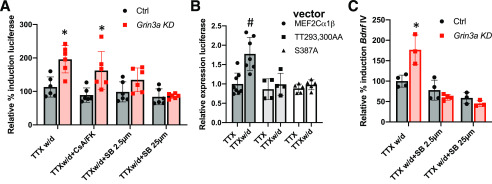Figure 4.
p38 MAP kinase activity is required for Bdnf IV potentiation. A, Luciferase expression in hippocampal neurons cotransfected with the UAS-Luc plasmid, a Gal4-MEF2Cα1β expression vector, and either the Grin3a shRNA1 plasmid or its paired control. Hippocampal neurons were stimulated for 6 h with TTX w/d in the absence of presence of cyclosporin A plus FK506 (CsA/FK) or SB203580 at the doses indicated. Induced luciferase levels are shown as percentages of induction relative to the control at 100%. Two-way ANOVA for virus, F(1, 40) = 25.07, p < 0.0001; for treatment, F(3, 40) = 8.724, p = 0.0001; and for virus–treatment interaction, F(3, 40) = 3.620, p = 0.021. n = 6/condition. Grin3a KD versus Ctrl for TTX w/d, p = 0.0005; for TTX w/d+CsA/FK, p = 0.0021. B, Luciferase expression in hippocampal neurons cotransfected with the pUAS-Luc plasmid, expression plasmids encoding the indicated Gal4-MEF2Cα1β vectors, and the Grin3a shRNA1 plasmid. Data are shown as fold change in luciferase levels compared with the WT MEF2Cα1β in TTX. Two-way ANOVA for vector, F(2, 27) = 10.53, p = 0.0004; for treatment, F(1, 27) = 10.41, p = 0.0033; and treatment–vector interaction, F(2, 27) = 5.590, p = 0.0093. n = 8/group for WT plasmid, 4 for TT293,300AA, and 5 for S387A. For Gal4-MEF2Cα1β TTX versus TTX w/d, p = 0.0002. C, Levels of Bdnf IV mRNA in hippocampal neurons infected with the indicated lentiviruses and then stimulated with TTX w/d. During TTX w/d, neurons were left untreated (Ctrl) or SB203580 was added. mRNA levels are reported as percentages of induction relative to the control. Two-way ANOVA for virus, F(1, 15) = 3.09, p = 0.01; for treatment, F(2, 15) = 36.48, p < 0.0001; and for treatment–virus interaction, F(2, 15) = 12.88, p = 0.0006. n = 3, except for Ctrl TTX w/d, n = 4. Ctrl versus Grin3a KD for TTX w/d, p = 0.0014. *, p < 0.05 Grin3a KD versus Ctrl; #, p < 0.05 TTX w/d versus TTX.

